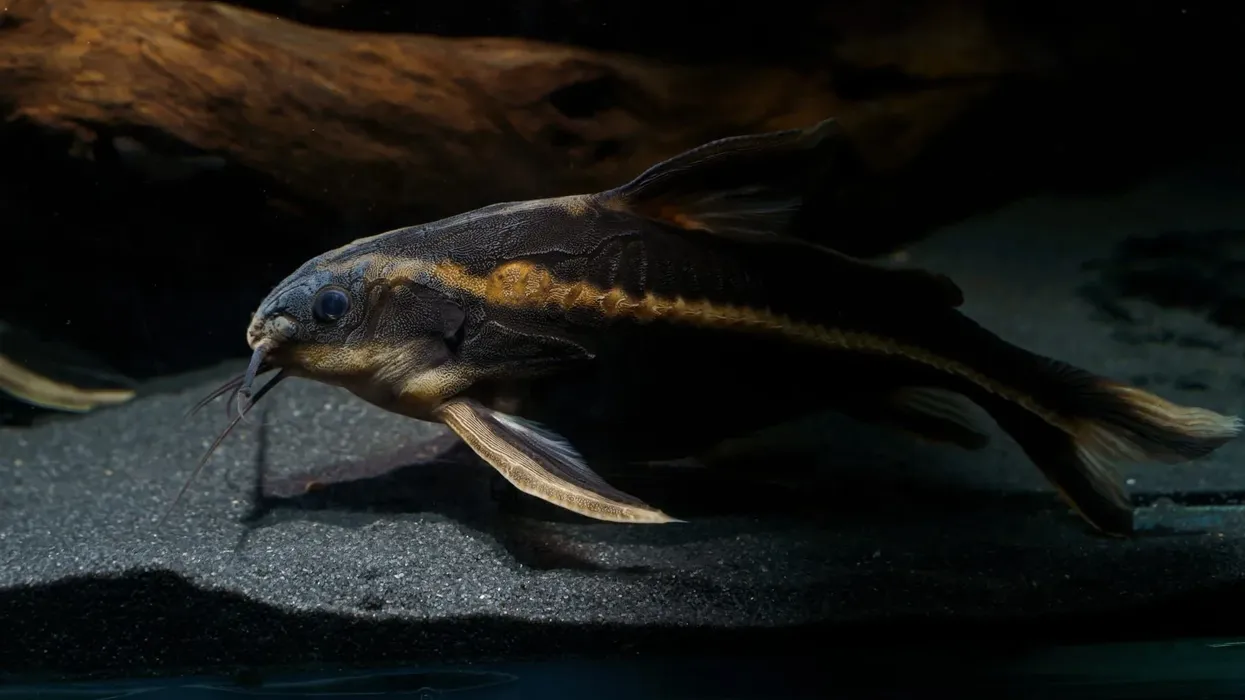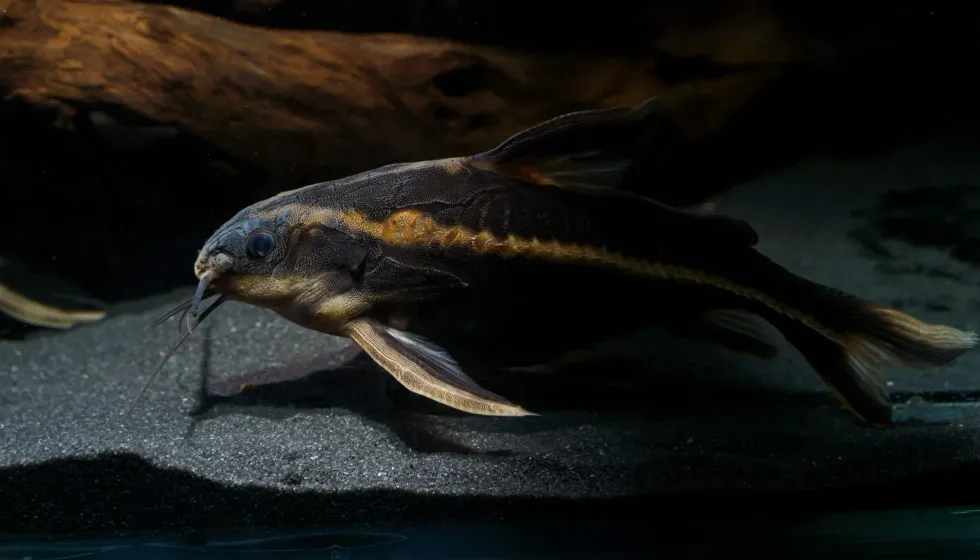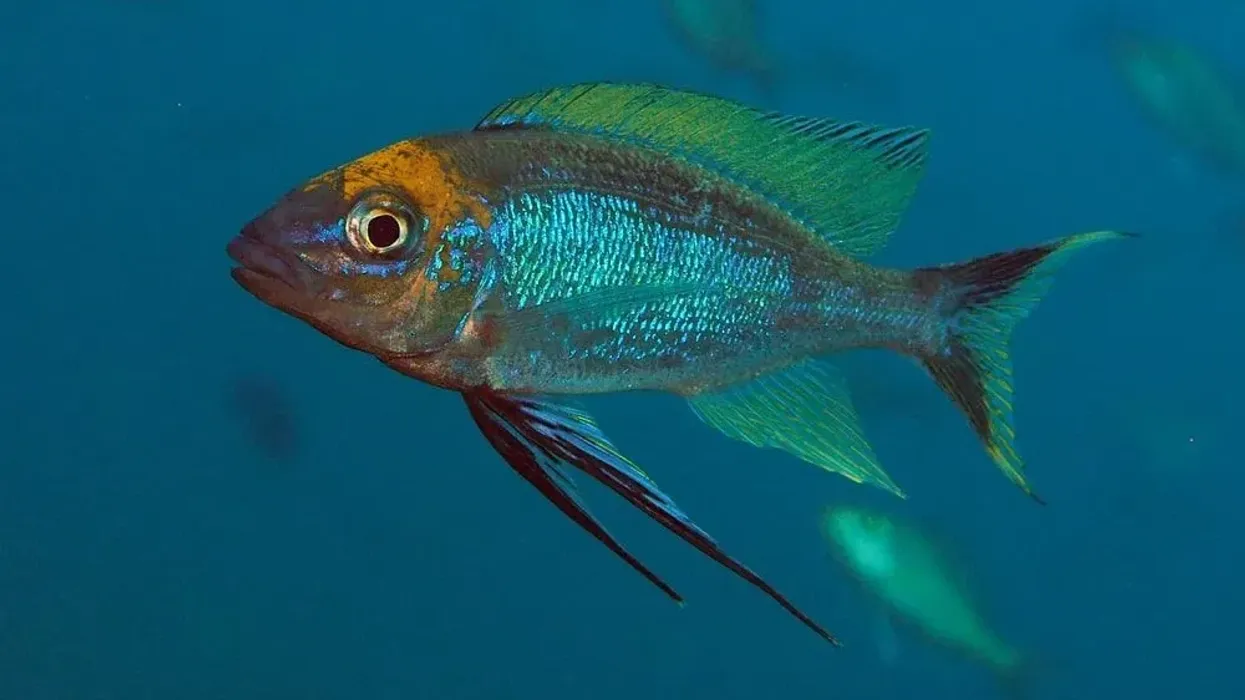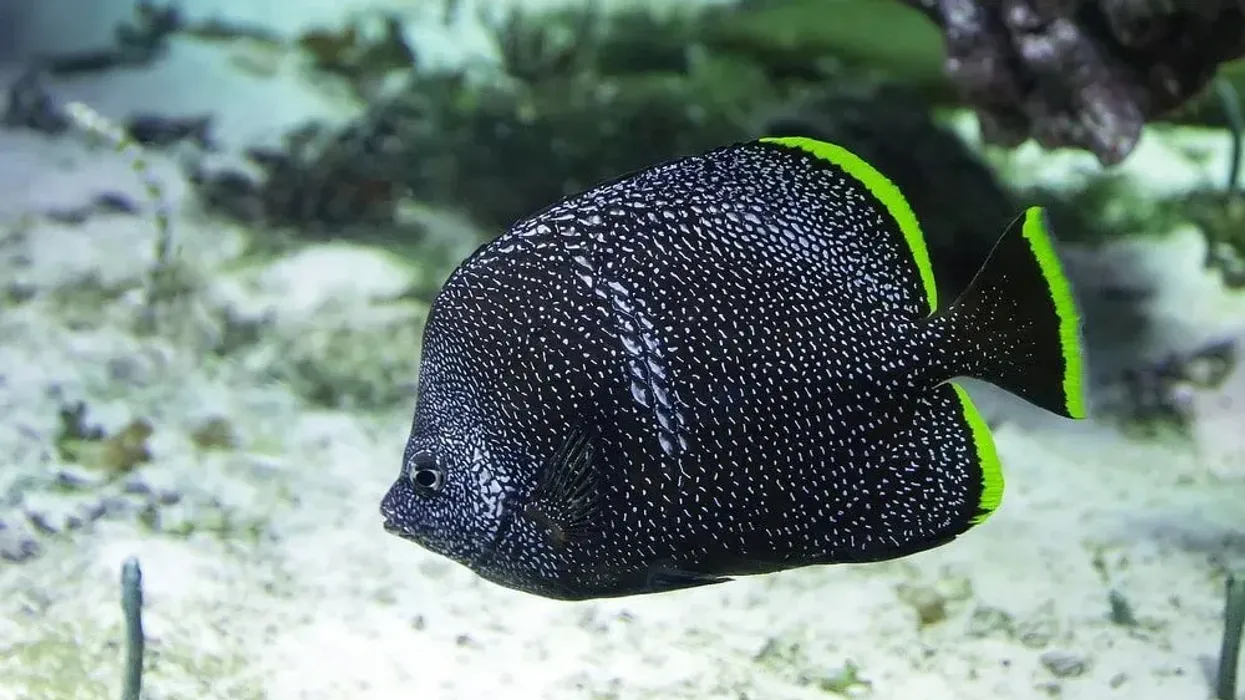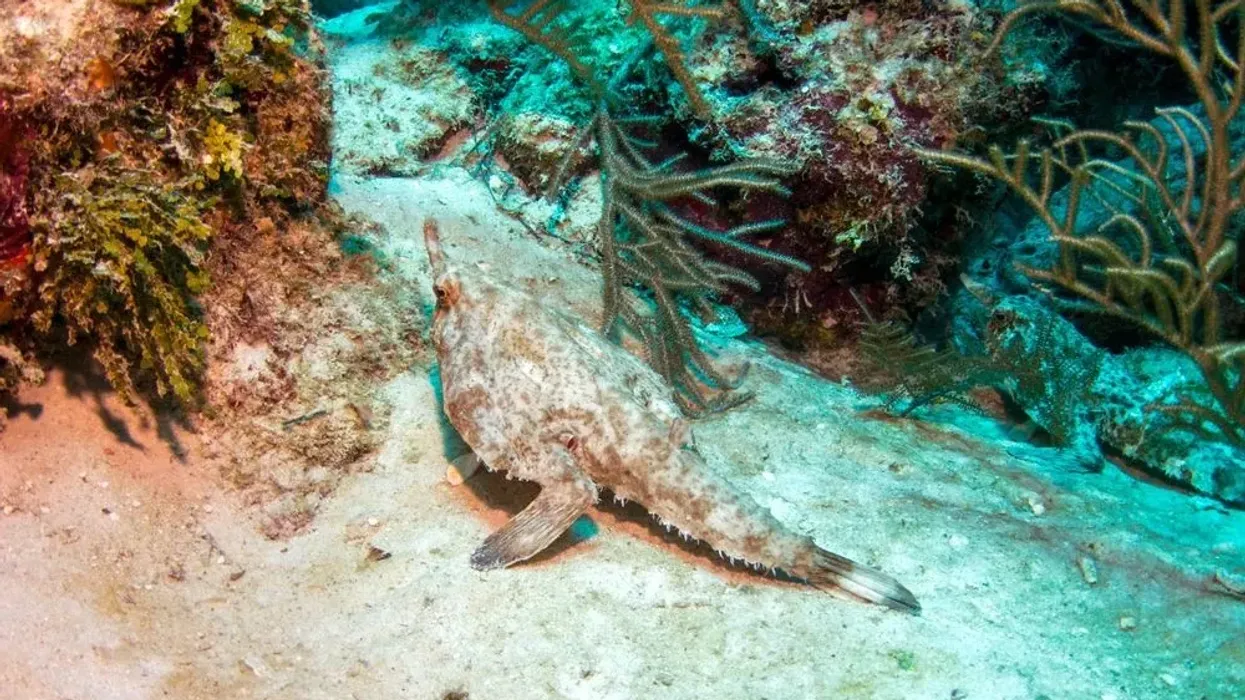The striped Raphael catfish is a catfish species native to the continent of South America. It is seen in the Paraguay–Paraná, Amazon, and lower Orinoco basins and it likes to live near sandy bottoms of rivers and streams.
Striped Raphael catfish is mostly black or dark brown in color and it has white stripes running the length of its body, which is how this fish got its name.
This freshwater fish has spines on its body and fins that become erect when it detects predatorial danger. The striped Raphael catfish is also a very popular aquarium fish due to its peaceful demeanor and is known to live for 10-15 years in captivity.
The better its care, the longer it lives.
All pet striped Raphael catfish are caught from their wild habitats because this fish is unable to breed in captivity due to the absence of a moving river. The species has a conservation status of Not Evaluated according to the IUCN.
For more relatable content, check out these rainbow cichlid facts and drum fish facts for kids.
Striped Raphael Catfish Interesting Facts
What type of animal is a striped Raphael catfish?
The striped Raphael catfish (Platydoras armatulus) is a fish.
What class of animal does a striped Raphael catfish belong to?
The striped Raphael catfish (Platydoras armatulus) belongs to the Actinopterygii class of animals.
How many striped Raphael catfish are there in the world?
It is unclear how many striped Raphael catfish (Platydoras armatulus) there are in the world. It is a very common freshwater aquarium fish and for similar reasons, its populations have not been evaluated by the IUCN either.
Where does a striped Raphael catfish live?
The striped Raphael catfish (Platydoras armatulus) is endemic to South America. It is found in the Paraguay–Paraná, Amazon, and lower Orinoco basins.
The wild habitat range of striped Raphael catfish is massive, covering places like Venezuela and Colombia (in the Rio Orinoco basin), Guyana's Rio Essequibo, French Guiana & Suriname's coastal drainages, and Peru, Brazil, and Bolivia in the Amazon basin. The basins of Rio Parnaíba and Rio Tocantins in Brazil have striped Raphael catfish too.
What is a striped Raphael catfish's habitat?
Striped Raphael catfish (Platydoras armatulus) favor moving waters in rivers and streams. In the wild, this catfish lives in creeks, swamps, and tributaries. It often takes shelter among submerged vegetation and roots. It is also a popular aquarium fish as well.
Who do striped Raphael catfish live with?
Striped Raphael catfish are very secretive and solitary during the day. In personal aquariums, they are more social and peaceful.
How long does a striped Raphael catfish live?
Striped Raphael catfish are known to live for around 10 years in captive situations with some living for up to 15 years. These fish are sensitive to habitat quality and water conditions. If the living conditions are poor, they live for a shorter period of time. Striped Raphael catfish live longer with vigilant care.
How do they reproduce?
Striped Raphael catfish reproduce by spawning and egg-laying. In their wild habitat, female fish release their eggs into streams and rivers to be fertilized by males. Striped Raphael catfish may also possibly build nests like others in the Doradidae family. They multiply in rivers with fast-moving waters.
Striped Raphael catfish never breed in captive tanks. It is because their natural environment of moving waters in rivers cannot be stimulated in tanks.
The only way they are bred outside their natural habitat is through hormonal injections. In very large tanks, a few spawnings have been reported. Striped Raphael catfish sold in the pet trade are all mostly caught from their wild habitats.
What is their conservation status?
The conservation status of the striped Raphael catfish species is Not Evaluated by the International Union for Conservation of Nature.
Striped Raphael Catfish Fun Facts
What do striped Raphael catfish look like?
The overall shape of the striped Raphael catfish resembles a torpedo. These fish have wide and large heads, but their bodies taper off coming up to the tail. The overall color of striped Raphael catfish can be described as black or dark brown.
They get their name from the lateral white stripes that run along their entire body's length. The white stripes may sometimes look yellowish.
Either side has a thicker stripe and a thinner one on the head. The thicker stripes coincide on the head. The belly is white too and looks like a third stripe meeting with the pectoral fins.
The striped Raphael catfish has a configuration that is very protective. There are curved spines present along the lateral line of the body. They also have rigid and very sharp ray fins. When threatened, these fish immediately raise their pectoral fins. The pectoral fin's front ray is sharply hooked and serrated.
Striped Raphael catfish also have three barbel pairs. The upper jaw has the longest pair and the other two are situated on the lesser mandible.
It is believed that females are slightly larger, duller, and rounder than males but there is not much data to back this. There is a clear distinction between juveniles and adults, however, juveniles have much brighter colors. Juveniles possibly have brighter colors to identify themselves as harmless.

How cute are they?
The striped Raphael catfish is a good-looking fish. It is a beautiful dark brown color overall and has gorgeous white stripes.
The barbels give it a certain gravitas but take away from its beauty. It is spiky on the fins and all over its body. The best thing about this fish is its peaceful manner and calm, easy-going demeanor which is why it is a popular aquarium fish.
How do they communicate?
Striped Raphael catfish are also known as 'talking catfish'. This name comes from their ability to make sounds while 'talking' to others of its kind.
There are two ways these sounds can be produced. One way is to lock the pectoral fins into their sockets, but only partially. The grinding of the spines on the pectoral fins against their sockets produces a buzzing sound.
Another way to produce sound is via rapid relaxation and contraction of the muscle attached to the skull's backside. The other end of this muscle is fixed to the swim bladder's front side. Moving this muscle makes the bladder resonate and it produces a deeper sound.
Both these sounds are very audible, even through the glass of the aquarium.
How big is a striped Raphael catfish?
Striped Raphael catfish are typically 7.9-9.4 in (20-24 cm) long. This makes them five to six times bigger than black neon tetras as well as golden tetras. They are also two to three times bigger than Congo tetras.
The striped Raphael catfish full size has rarely been known to go up to 17 in (43 cm).
How fast can a striped Raphael catfish swim?
Being a catfish, the striped Raphael catfish, or talking catfish, can probably swim at speeds close to 2.6 mph (4.2 kph).
How much does a striped Raphael catfish weigh?
Striped Raphael catfish, or talking catfish, can weigh up to 8.1 oz (230 g).
What are the male and female names of the species?
There are no specific names used to refer to the striped Raphael catfish species.
What would you call a baby striped Raphael catfish?
A baby striped Raphael catfish may be called a fry or a juvenile.
What do they eat?
Striped Raphael catfish are bottom feeders and they eat crustaceans, mollusks, and organic debris in the wild.
In captive tanks, they eat bloodworms, small earthworms, brine shrimp, sinking pellets, feeder shrimp, algae wafers, flakes, and tubifex.
Are they aggressive?
Striped Raphael catfish are not aggressive but they are defensive. When they sense a threat, all the spines on their fins and bodies become rigid. These spines can really hurt if you are not careful while handling the fish. The pain has been described as eye-watering.
Would they make a good pet?
Yes, they do make good pets and they are very popular among owners. They are nocturnal and search for food when the lights go out, so keeping the tank dimly lit is advisable.
These nocturnal tendencies may go away after some time. Striped Raphael catfish are peaceful fish and do not show much aggression.
However, this fish can mistake smaller fish for food and eat them, so it is best to keep them with fish that are as big as them.
They can survive and protect themselves with larger, more aggressive fish thanks to their spiny bodies. Some suitable tank mates include black skirt tetras, jaguar cichlid, bristle nose pleco, African butterflyfish, Pictus catfish, oscar fish, Congo tetras, and bichirs.
Striped Raphael catfish are adaptable to pretty much any water condition but they should still be monitored for their health. A striped Raphael catfish tank size should at least be 50 gal (227.3 L).
Smaller tanks will make them uncomfortable and stunt their growth. These fish love dwelling in sandy bottoms, so providing a soft bottom and places to hide is important.
They are even known to bury themselves in the sand to protect themselves. A striped Raphael catfish hiding among vegetation is a common sight so pipes, driftwood, aquarium plants, and caves should also be provided as places of shelter.
The ideal striped Raphael catfish water temperature is 75-80 F (23.9-26.7 C), at a pH level of 6-8, and at a hardness of 4-20 dKH. The diseases and conditions that the striped Raphael catfish is susceptible to include fungal infections, ich, and parasitic infections.
Keeping the water in good conditions is essential in keeping these away. Continuous quality monitoring, regular water changes every week, and providing the right food make for a good care routine.
Did you know...
Striped Raphael catfish are notoriously slow growers, increasing only an inch every year or two until it reaches its mature size.
The striped Raphael catfish was often confused with other Platydoras fish species like Raphael catfish (Platydoras costatus). The Raphael catfish is found in French Guiana and Suriname and the most notable difference is that the pale stripe does not continue on to the fish's head.
How did the striped Raphael catfish get its name?
The striped Raphael catfish is called this because of the white stripes it has on its body. Other names that are used to refer to the fish are southern striped Raphael, chocolate doradid, talking catfish, and thorny catfish.
Are striped Raphael catfish poisonous?
No, these talking catfish are not aggressive or poisonous. They are known to erect spines on their bodies when they feel threatened. If handling this freshwater fish with erect spines, you're likely to get hurt and feel an eye-watering pain.
Here at Kidadl, we have carefully created lots of interesting family-friendly animal facts for everyone to discover! Learn more about some other fishes from our Siamese fighting fish fun facts and spiny dogfish fun facts for kids pages.
You can even occupy yourself at home by coloring in one of our free printable striped raphael catfish coloring pages.

